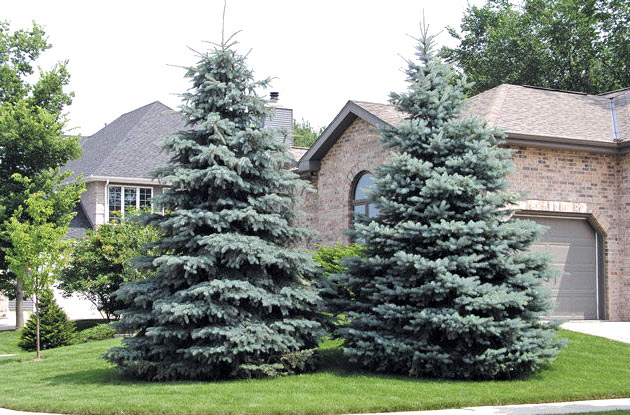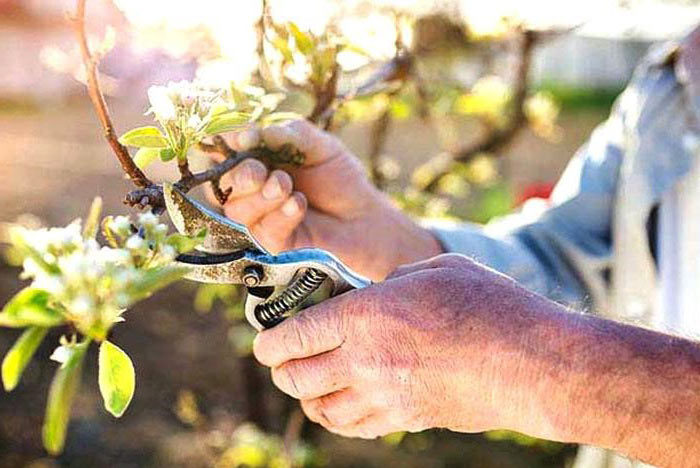Trimming your at the right time is very important to keep them healthy and to avoid killing them. Some tree species need to be trimmed when they are dormant before leafing season while others can be trimmed at any time as required.
It is OK to trim some trees in summer like pines and most evergreens. It is recommended trimming is limited to dead or broken branches on other trees. The end of winter is the ideal time for trimming as trees have a full season ahead to heal wounds and begin new growth. Summer trimming can put extra pressure on an already stressed tree.
Below we look at the types of trees that don’t mind a summer trim, and reasons to trim any tree in summer.
If you are trimming for safety reasons- say after storm damage– or to remove large dead branches, then you can trim any tree in any season, including summer. However, limited summer trimming can be done for the following trees without causing too much damage or preventing growth:
Blue Spruce, Western Red Cedar, Eastern Hemlock

These and many other evergreen varieties except pines can be trimmed in the summer albeit with moderation. Summer trimming for evergreen trees can be done towards the middle of the summer. This way, the tree will have ample time to develop new branches and produce more leaves when spring comes in the summer. These evergreen trees retain much of their foliage through the fall and winter so trimming them as needed will not affect them.
When trimming evergreen trees, it’s important to follow the natural branching pattern and also avoid cutting too close to the main branches or the trunk. Doing this will allow the tree to retain much of the nutrients usually stored at the base of the branches and utilize them when they get dormant in the winter before spring. Also, avoid trimming the leader branch as some may not be able to grow it back. Instead, you should focus on the neighboring branches to allow the leader branch to grow and form the shape of the tree.
Note that mature evergreen trees rarely require trimming unless you are doing it to remove deadwood, to shape the crown, or remove weakened branches after a storm. Younger evergreens do however need more frequent trimming (at least once every two seasons) to promote growth and guide the shape of the crown.
Some Fruit Trees
Maintenance trimming for most fruit tree species can be done at the beginning of spring or summer. Maintenance trimming is usually done to either get rid of dead branches that are no longer viable for fruit production or fruit thinning. Keep in mind that trimming healthy branches from most fruit trees in summer will have a direct effect on fruit yield as most of them won’t develop the buds needed to produce fruit or bloom when the season comes. On the other hand, pruning or trimming to get rid of dead and decaying branches will make the fruit trees healthier and may increase yield.
Maple Trees, Birch and Walnuts (And Other Sap Producing Trees)
It’s advisable to trim or prune sap-producing trees such as walnuts, maples, and Birch trees in the summer because it is the time when they are least likely to lose too much sap (water). Trim these trees in the middle of summer or towards the end to allow for the sap to dry out and also allow enough time before the tree can start growing again in spring. Trimming these trees in spring or winter is not a good idea as they will end up losing a lot of water in the form of sap (in spring) or vital nutrients needed during dormancy (in winter).
Why Is It Bad to Heavily Prune Trees in Summer?

Pruning trees in the summer should be minimized to removing small sections of branches or getting rid of dead, weak, or sick limbs or branches. Heavy pruning in summer is generally not a good practice and may not have the best outcomes for the following reasons:
The tree is not actively growing in summer– most trees are not developing any new limbs or leaves in the hot and dry summer months especially those that will shed leaves in fall as they prepare for winter dormancy. This means heavy pruning will deny a tree vital food sources (water and stored nutrients) before it starts growing again towards the end of winter. For trees that can close the wound and grow in the summer, they end up spending too much of the stored nutrients and don’t recover fully.
Excessive drying– Summer temperatures and sun intensity will cause too much drying if a tree is significantly trimmed. It’s not uncommon for an entire tree to dry if it does not have enough foliage to withstand summer weather and winter dormancy.
Heavy trimming in summer should only be done if the tree is too large, has a dense crown, or if you want to restrict its size. Bonsai trees are often trimmed and tied down in the dormant seasons for this very purpose- to restrict growth.





5 Reasons Pruning Trees in Summer Is A Good Idea
While summer pruning is restricted to a few trees and also limited to certain conditions, it does have a few benefits. Here are some of them:
1. If You Are Pruning Due to Storm Damage
You certainly don’t have to wait until spring or winter to trim large damaged branches off a tree. Given that such branches tend to dry out or decay in the hot summer sun, this is usually the best time to have them removed for safety purposes. You will also have an easier time identifying the damaged limbs and determining the extent to which the tree should be trimmed and remain healthy as the limbs will be dry and there is less foliage in summer.
2. If You Just Transplanted A Tree
Transplanting can be done in the summer provided the tree is properly watered. It’s recommended to trim a transplanted tree in summer to reduce the stress required to grow or maintain foliage in the hot summer sun. However, pruning a freshly transplanted tree is a job best left to the experts. You need to know just how much trimming can be done when the tree is barely growing and having to adapt to a new environment.
3. If the Tree Is Not Looking Healthy
Trees have to spend more nutrients and energy to maintain foliage in the summer due to the weather conditions. If the tree appears stressed in the summer or at the beginning of the season, then trimming it might help keep it healthy as it will have less foliage to maintain.
You can tell when a tree needs trimming If leaves are yellowing or there are too many dry branches and stressed limbs. Ensure that you trim a few inches from the stem or main branches so that you leave as much nutrients to the tree to survive summer and winter.
4. To Shape the Crown After Powerline Clearance
If your tree loses its shape after mandatory powerline clearance in summer, then you might find it necessary to have it pruned or trimmed to the desired shape or to maintain its balance. Sometimes powerline companies can cut the central leader branch through trimming and direct growth to the next largest branch.
5. Removing Pests and Climbers
Some pests and climbing plants will put undue strain on a tree in summer. Trimming branches that have pests or climbers on them can help keep the tree healthy.
Why Should I Avoid Pruning Oak Trees in Summer?
While you can get away with a bit of summer trimming for most trees, you should avoid touching oak trees in summer. The prevalence of disease-causing pests and pathogens in summer makes oak trees vulnerable to oak wilt which can cause severe damage to major branches and stems that are cut open. While some people advise that you paint the cuts, it’s better to delay the pruning until winter.
Is There A Better Time of Year to Trim Trees Than Summer?
The best time to trim most trees is usually in spring just before new buds are formed and when the tree is more likely to recover and develop fresh foliage. Spring trimming is mostly done in the early stages of the season or the middle depending on the tree and its growth patterns.
Should I Hire A Professional?
Are you stuck between hiring a professional to trim your trees or going the DIY route? While both options are viable, most people would find it more convenient to hire a professional for the following reasons:
Costs- It’s usually cheaper to hire a professional to trim your trees than it is to hire or buy equipment, get the required permits, and spend time climbing and trimming your trees.
Safety- Professionals have the required personal protective equipment to safely climb and trim your trees without causing damage to nearby structures. Trimming large branches off mature trees can be a dangerous exercise for non-professionals.
Trimming expertise- Trimming is not just about cutting branches off a tree, professionals know what kind of cuts to make and at which point to maintain the health of the tree and get the best results.






